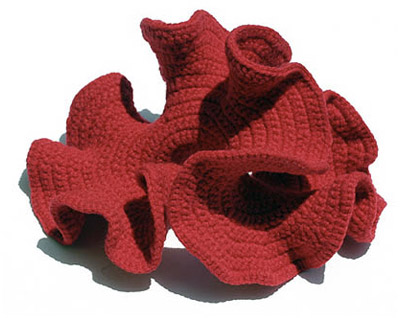 |
|
|||
Click here to view all Upcoming Events// IFF Directors Talks
IFF Directors Talks 2012 // Previous IFF Lectures THE MOSELY SNOWFLAKE SPONGE THE ART OF ITERATION MAKING SPACE IFF Director Margaret Wertheim speaks at Art Center College of Design Captain Charles Moore Talks About Plastic Trash IFF Director Margaret Wertheim Seeing Anew [IFF-L20] Structural Considerations of the Business Card
Sponge[IFF-L17] Where the Wild Things Are 2: Things That Think: Where the Wild Things Are: Crocheting the Hyperbolic Plane: Darwinism on a Desktop: The Logic Alphabet Why Things Don't Fall Down Kindergarten: Crocheting the Hyperbolic Plane [IFF-L5] The Mathematics of Paper Folding [IFF-L4] The Physics of Snowflakes [IFF-L3] Crocheting the Hyperbolic Plane [IFF-L2] The Figure That Stands Behind Figures: // Previous Events Crochet Hyperbolic Workshop
|
Crocheting the Hyperbolic Plane: |
|||
Saturday, February
5, 2005 @ 5pm Cornell University mathematicians David Henderson and Daina Taimina will present a talk about non-euclidean geometry and their discovery of crocheted models of hyperbolic space - a spatial structure found in the crenellation of lettuce leaves, the anatomy of sea slugs, and potentially in the shape of the physical cosmos. Lecture number five in The Institute for Figuring Inaugural Lecture Series: “Figuring Space.” |
||||
 |
||||
| Crocheted model of hyperbolic plane by Daina Taimina |
||||
| Daina Taimina and David Henderson are mathematicians at Cornell University. They are co-authors of Experiencing Geometry a classic text on euclidean and non-euclidean space. In 1997 Daina worked out how “hyperbolic” space could be modeled by crochet. Since then, she and David have used her woolen models to further explore this peculiar topology. Here, David and Daina will talk about crocheting the hyperbolic plane, the geometry of lettuce, and the architecture of the universe. //Fluted and crenelated, the leaf of a lettuce curves away from itself. From the modest beginning of the stubby stalk where it abuts the stem, to the flared and scalloped edge, the space literally expands, each point seeking to maximize its domain. Lettuces, cabbages and certain types of kelp all embody hyperbolic geometry - the geometric opposite of the sphere. Used to model the World Wide Web and the structure of the human brain, hyperbolic space deviates from rectilinear norms. In “flat” or Euclidean space parallel lines remain equidistant, but on curved surfaces a more complex topology reigns. Think of the surface of the earth: here, lines of Longitude are “parallel” at the equator yet intersect at the poles. In hyperbolic space, parallel lines curve away from each other - the further one travels from any point the more room there is. For Isaac Newton and his followers, physical space was Euclidean
- endless, formless and flat. But in 1919 measurements of starlight
bending around the sun showed that space is intrinsically curved.
In one recent model proposed by physicists, our universe is shaped
like soccer ball; in another it resembles a trumpet. The WMAP satellite
currently taking pictures of the distant cosmos may at last determine
which, if any, of the proposed models describes the global geometry
|
||||
| see also: PRESS - Hyperbolic Models on NPR's All Things Considered! Interview with David Henderson and Daina Taimina A gallery of hyperbolic models Download a pdf* to create a hyperbolic soccer ball *pdf download requires Adobe Reader or Apple Preview |
||||
| © 2003–2018 The Institute For Figuring | ||||